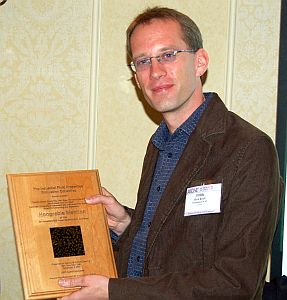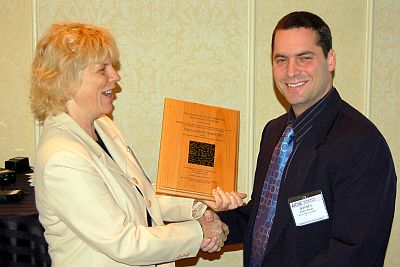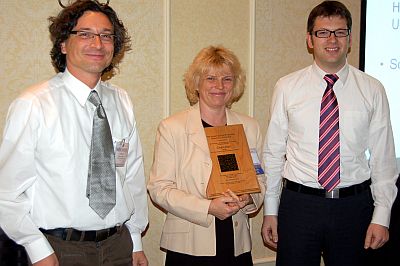Champions Announced for the 4th Industrial Fluid Properties Simulation Challenge
The culmination of the 4th Industrial Fluid Properties Simulation Challenge occurred at a session on November 8 at the AIChE annual meeting in Salt Lake City, Utah. Announced in San Francisco in November of 2006, the IFPSC challenged entrants to calculate a wide range of thermodynamic and transport properties for new molecular models of ethylene oxide at 375 K. Five teams accepted the challenge and were judged based on the comparison of the properties of their new models to a set of benchmark data. Participants were honored at the AIChE session with plaques and cash prizes and gave presentations describing their work.
Receiving the title of champions and an award of $2000 were Bernhard Eckl, Jadran Vrabec, and Hans Hasse from the University of Stuttgart who scored 331 out of a possible 350 points. In close competition for second place were entries by Jake. L. Rafferty, Neeraj Rai, Manish S. Kelkar, J. Ilja Siepmann, and Edward J. Maginn from the University of Minnesota and the University of Notre Dame and by XiaoFeng Li, Lifeng Zhao, Tao Cheng, Lianchi Liu, and Huai Sun of Shanghai Jiao Tong University. Also entering and performing well were a team featuring MaryBeth H. Ketko, Jake Rafferty, J. Ilja Siepmann, and Jeffrey J. Potoff of Wayne State University and the University of Minnesota and a team comprised of Thomas Müller, Sudip Roy, Wei Zhao, Florian Müller-Plathe, Astrid Maaß, and Dirk Reith from the Technical University of Darmstadt (Germany) and the Fraunhofer Institute for Scientific Computing and Algorithms.
"We were impressed by the quality of the entries and the hard work that was invested to develop models that perform well for a wide range of properties," commented Anne Chaka (NIST), one of the challenge organizers. "The same types of non-bonded interactions that you have to get right to predict the properties of EO in the gas and liquid phases are also critical in many other extremely important applications in a wide range of industries, like pharmaceuticals for example,...which is why this type of work is so important," she added. "The international representation, with entries from Europe, Asia, and the U.S., was quite encouraging...as was the general level of consistency between the different groups for their predictions for the round-robin model," commented Jonathan Moore (Dow Chemical), also one of the challenge organizers.
The primary objective of the challenge was to test the transferability of methods and force fields to a wide variety of properties for a given small molecule, EO. Researchers working in an industrial setting are commonly asked to predict a wide range of physical properties, so a method that is able to predict a broad range of properties (especially properties that were not used in the original model parameterization) may be more valuable in this situation than a method that may provide more accurate results but only for one property or property type. A secondary objective was to assess the variability of property predictions performed by different researchers using the same force field (a "round-robin" experiment). Entrants were required to submit property predictions for this common "round-robin" model in addition to newly-developed models. Ethylene oxide was chosen as the subject of the challenge for several reasons: 1) it has significant industrial relevance, 2) it is flammable, reactive, and toxic - so it is a good candidate for avoiding experimentation via use of modeling, and 3) it is a small molecule, so it was less computationally-demanding to calculate its properties compared to larger molecules. More details about the challenge are available at: http://fluidproperties.org/challenge/4th/announcement
The cash prizes and plaques were provided to the participants using financial donations from BP, Dow Chemical, DuPont, Mitsubishi Chemical, and 3M. Previous As has been the case for each of the challenges, journal articles describing the 4th challenge and the five entries will be published in a special issue of Fluid Phase Equilibria. The simulation challenge is organized on an annual basis by the Industrial Fluid Properties Simulation Collective (IFPSC, http://fluidproperties.org). It is expected that they will announce a 5th challenge early in 2008. The simulation challenge is one component of the IFPSC's strategy to achieve it's vision, namely:
A robust, accurate, and easy-to-use set of modeling tools will be widely available for the prediction of physical properties of fluids and obtaining insight into the connections between molecular structure and properties. As a part of this tool set, molecular simulation will become a breakthrough technology that is widely accepted in the chemical industry and applied in conjunction with other predictive methods to meet the industry's evolving fluid property data needs. Through an international collaboration (IFPSC) between industry, academia, and national labs (coordinated by the National Institute of Standards and Technology), we will develop Standard Reference Simulations, validation of methods, quantification of uncertainty, force field and simulation databases, communication standards between computer programs, and recommendations regarding the use of other predictive methods, thus enabling users to select the appropriate tools to achieve results with requisite accuracy and insight.
Documents from the challenge session:
- Agenda (link, .ppt, 20 KB)
- Introduction (link, .ppt, 1.4 MB)
- Benchmark Data (link, .ppt, 617 KB)
- Comparisons of entries and announcement of champions (link, .ppt, 202 KB)
- Discussion of future challenges (link, .ppt, 35 KB)
Photos

Dirk Reith from the Fraunhofer Institute for Algorithms and Scientific Computing (Germany)

Anne Chaka congratulating Jeff Potoff of Wayne State University

Huai Sun of Shanghai Jiao Tong University (China)

J. Ilja Siepmann of the University of Minnesota

Jadran Vrabec and Bernhard Eckl of the University of Stuttgart (Germany)